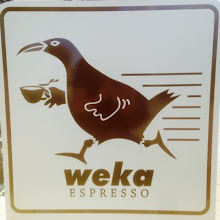Imagine being locked in a chocolate shop for two hours on a long weekend surrounded by irresistible chocolate treats. That's exactly what nine of us did on Saturday with a hands-on
chocolate class at Bohemein.
 |
| *drool* |
 Bohemein
Bohemein make amazing fresh chocolates with mouth watering truffles and great gift ideas. Owner and chocolatier Jiri Havlik (better known as George) also runs weekend hands-on chocolate classes in their Featherston Street store. Apart from being an experienced end-user of the product, my chocolate making skills have only ever extended as far as
remelting chocolate melts to set in various moulds. I had a lot to learn!
We started out by learning how to make dark chocolate
ganache correctly. Although I have made ganache a few times for cake and cupcake decorating, my success has largely been hit and miss. George showed us some good techniques for combining the chocolate in cream that had been brought to the boil. I learned what it means to 'split' the ganache (you don't want that to happen) and think that is what might have been the problem during some of my ganache disasters. This ganache was to become the filling for the 70% truffles we made later.
George helped us unravel the science of chocolate making and make sense of the process. I knew that
tempering involved raising, lowering and then raising the temperature of chocolate again to make it workable but never really understood why this was necessary. If I'm honest, I actually thought you could probably skip this step - but now know why it's essential and how to do it! (This article is a good guide to
chocolate tempering.) It is all about creating type V (5) crystals which allow you to work with the chocolate at its best, leaving a glossy finish and a delightful
snap.
Temperature is all important when pre-crystalising (tempering) chocolate and some tools of the trade are necessary. Firstly, a digital infra-red thermometer was recommended for its accuracy. I knew my sweetie (gadget man) had one of those and we laughed about what else he might have that I could commandeer for chocolate making at home. Melting the chocolate is done on a
bain-marie (double boiler) and cooling is easy with a cheap fan. Reheating, however, is different. A heat gun with a variable thermostat is best, but most people don't have these on hand. Although a hair dryer could suffice, George laughed that he didn't own one. (Check out his picture to see why.) Concerned that I also
don't own a hair dryer, I wasn't sure what I could use at home but suspected that, once again, my sweetie would have the required equipment in his garage. Yep, he does, and so my friend and I will now make chocolate at our place. :-)
 |
| Truffle assembly line |
We created a kind of
truffle assembly line, dropping the ganache pieces into the tempered chocolate then draining off the excess with a special chocolate fork. Then, it was into the pile of chocolate shavings before rolling the completed truffle forwards to set on baking paper. We got to make six of these 70% dark truffles each and they were bagged up for us to take home. They looked very professional!
 |
| Truffles to take home |
Although there is a lot more science involved in chocolate making than one would initially imagine, it is obvious from George that the essential ingredient is passion. You can see by just looking at his amazing chocolate creations that this is far more than just a commercial interest. I was blown away by the creativity of this kiwi sculpture. The marble slab, egg and flowers are all made from chocolate. Impressive!
 |
| Inspiration! |
I highly recommend this chocolate making class at Bohemein for chocolate lovers and bakers alike. I now have some great ideas for making Christmas presents and will top them up with goodies from the shop. In the meantime, practice makes perfect so that gives me a great excuse to
eat make a lot of chocolate.










